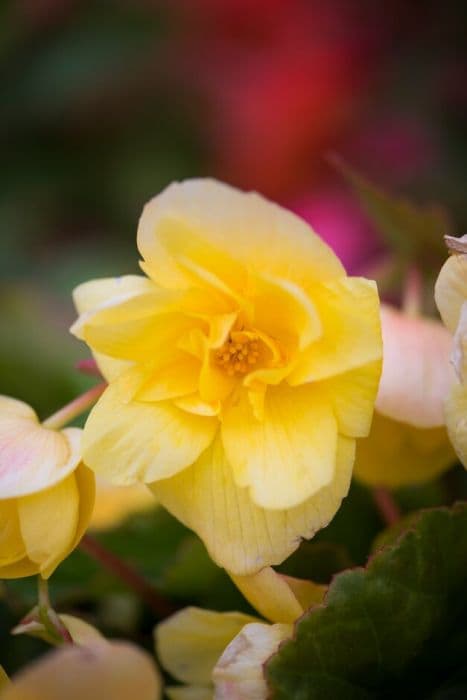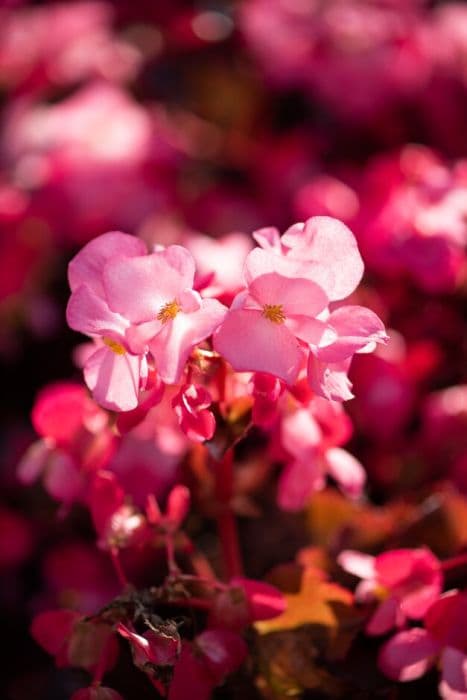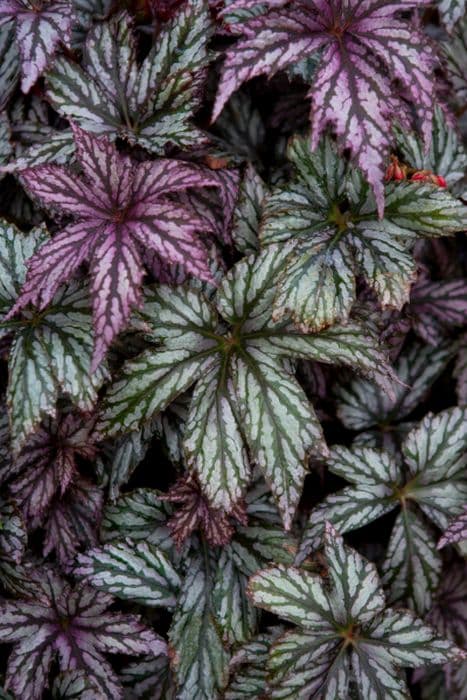Victoria Falls Begonia Begonia 'Victoria Falls'

ABOUT
The Begonia 'Victoria Falls' is known for its stunning foliage which cascades in a graceful manner, reminiscent of a waterfall. The leaves are vibrantly green and typically feature a combination of colors which can include shades of red, pink, or silver. The leaf surface is often glossy, allowing the colors to shimmer under light. They might showcase intricate patterns such as speckles or marbling, adding to their ornamental appeal. The edges of the leaves can be serrated or wavy, contributing to the overall lush appearance of the plant. During its blooming period, the flowers of the 'Victoria Falls' Begonia emerge in clusters, displaying small but showy blooms that can range in color from white to pink or red, sometimes with a delicate, appealing fragrance. These blossoms add a touch of vibrant contrast against the foliage. The plant’s overall structure is such that it makes an excellent choice for hanging baskets or cascading elements in mixed containers, with its tendrils spilling over the edges in a soft, draping manner.
About this plant
 Names
NamesFamily
Begoniaceae
Synonyms
Victoria Falls Begonia
Common names
Begonia 'Victoria Falls'.
 Toxicity
ToxicityTo humans
Begonias, including the Begonia 'Victoria Falls', contain insoluble oxalates which can be mildly toxic when ingested. If a person eats any part of the plant, they could experience symptoms such as a burning sensation in the mouth or throat, swelling of the lips, tongue, and throat, difficulty swallowing, and vomiting. It's important to keep this plant out of reach of children who might accidentally ingest it.
To pets
Begonias, including the Begonia 'Victoria Falls', are also toxic to pets due to the presence of insoluble oxalates. Consumption of this plant by animals can lead to symptoms such as oral irritation, drooling, vomiting, and difficulty swallowing. Pets, especially cats and dogs, may exhibit signs of distress after ingesting parts of the plant and should be kept away from Begonias to prevent accidental poisoning.
 Characteristics
CharacteristicsLife cycle
Perennials
Foliage type
Evergreen
Color of leaves
Green
Flower color
Pink
Height
1-2 feet (30-60 cm)
Spread
1-2 feet (30-60 cm)
Plant type
Herb
Hardiness zones
10
Native area
Tropical South America
Benefits
 General Benefits
General Benefits- Ornamental Appeal: Begonia 'Victoria Falls' has striking foliage and cascading flowers that enhance the aesthetic of any garden or space.
- Versatility: This plant can thrive both indoors and outdoors, making it suitable for various gardening projects.
- Shade Tolerance: It can grow in shaded areas where other plants might not flourish.
- Low Maintenance: It does not require extensive care, making it ideal for novice gardeners or those with limited time.
- Drought Resistance: Once established, it can tolerate periods of dryness better than many other plants.
- Container Gardening: Its growth habit makes it an excellent choice for hanging baskets and containers.
- Bloom Longevity: The plant often has a long flowering season, offering prolonged visual interest.
- Attracts Pollinators: Its flowers can attract beneficial insects like bees and butterflies to your garden.
- Color Variety: Begonia 'Victoria Falls' offers a range of color options to suit different landscape designs and preferences.
 Medical Properties
Medical PropertiesThis plant is not used for medical purposes.
 Air-purifying Qualities
Air-purifying QualitiesThis plant is not specifically known for air purifying qualities.
 Other Uses
Other Uses- Photography Backdrop: Begonias, with their cascading blooms, can serve as a vibrant and lush background for close-up photography or portraiture.
- Edible Decorations: Some Begonia varieties are edible and can be used to adorn cakes and desserts with their colorful petals.
- Teaching Tools: Begonias are ideal for educational purposes, demonstrating plant propagation through leaves or stem cuttings in schools or workshops.
- Art Inspiration: The unusual patterns and colors of Begonia leaves can inspire artists for paintings, textile designs, or other creative endeavors.
- Natural Confetti: Dried begonia petals can be used as a biodegradable confetti for celebrations, adding a floral touch to events.
- Garden Borders: Begonias can be planted along garden paths or borders to define spaces with their dense foliage and blooms.
- Fashion Accessories: Fresh or dried Begonia flowers can be incorporated into accessories like brooches, hair pins, or boutonnieres.
- Custom Potpourri: Dry Begonia flowers and leaves to create a fragrant potpourri mix for scenting rooms.
- Fairy Gardens: These plants are perfect for adding to miniature fairy gardens due to their varied leaf shapes and sizes.
- Eco-friendly Dye: The pigments from Begonia flowers and leaves can be used to naturally dye fabrics and papers.
Interesting Facts
 Feng Shui
Feng ShuiThe Begonia is not used in Feng Shui practice.
 Zodiac Sign Compitability
Zodiac Sign CompitabilityThe Begonia is not used in astrology practice.
 Plant Symbolism
Plant Symbolism- Beware: In the language of flowers, begonias are often associated with warnings or cautiousness. This symbolism could express to be alert to potential dangers or to tread carefully in certain situations.
- Deep Thinking: Featuring intricate patterns, begonias can symbolize deep thinking and introspection, symbolizing the approach to analyze situations thoroughly before acting.
- Uniqueness: With their distinctive and cascading appearance, particularly in the 'Victoria Falls' variety, begonias can represent uniqueness or standing out from the crowd.
- Gratitude: Sometimes begonias are given as a sign of thankfulness or appreciation, due in part to their vibrant beauty and longevity.
- Harmony: The lush foliage and graceful habits of Begonia 'Victoria Falls' can signify a sense of harmony and balance in life, possibly due to their pleasing aesthetic in gardens and homes.
 Water
WaterVictoria Falls Begonia requires consistent moisture, but it is crucial to avoid overwatering which can lead to root rot. Generally, water the plant when the top inch of soil feels dry to the touch. Depending on the environmental conditions, this might be approximately once a week. Use room temperature water and gently water at the base of the plant until it begins to drain from the bottom of the pot, which can be about 16-24 ounces for a medium-sized pot. During the winter months, reduce watering frequency as the plant's growth slows down.
 Light
LightVictoria Falls Begonia thrives best in bright, indirect sunlight. A spot near a window that receives filtered light, such as behind sheer curtains, is ideal. Direct sunlight, especially in the hot afternoon, should be avoided as it can scorch the leaves. East or west-facing windows are often suitable locations for providing the optimal light conditions for this plant.
 Temperature
TemperatureVictoria Falls Begonia prefers temperatures between 60°F and 75°F, which are typically indoor room temperatures. Avoid exposing the plant to temperatures below 50°F, as cold drafts can cause damage. It's important to keep the Begonia in a place where it won't experience drastic temperature fluctuations, away from heating vents and air conditioners.
 Pruning
PruningPrune Victoria Falls Begonia to maintain its shape and encourage bushier growth. It is best to prune in the late winter or early spring when the plant is coming out of dormancy. Remove any dead or dying leaves and stems, as well as any leggy growth. This encourages healthier, more robust foliage and blooms. Depending on the plant's growth rate, additional light pruning may be needed throughout the growing season.
 Cleaning
CleaningAs needed
 Soil
SoilThe best soil mix for Begonia 'Victoria Falls' is a well-draining, lightweight mix with a combination of peat moss, perlite, and vermiculite. Its ideal soil pH is slightly acidic to neutral, ranging from 5.5 to 6.5. It's important to ensure the soil provides adequate aeration to prevent root rot.
 Repotting
RepottingBegonia 'Victoria Falls' should generally be repotted every 1-2 years or when it has outgrown its current container. The best time to repot is in the spring or early summer when the plant's growth is most active.
 Humidity & Misting
Humidity & MistingBegonia 'Victoria Falls' thrives in higher humidity levels, ideally around 60-70%. If the air in your home is dry, consider using a humidifier or placing the pot on a tray of moist pebbles to increase the ambient humidity around the plant.
 Suitable locations
Suitable locationsIndoor
Provide bright, indirect light and maintain high humidity.
Outdoor
Protect from direct sunlight; keep in warm, shaded areas.
Hardiness zone
10-11 USDA
 Life cycle
Life cycleBegonia 'Victoria Falls', like other begonias, begins its life as a seed, which germinates when environmental conditions such as moisture, light, and temperature are favorable. Upon germination, the seedling develops roots and shoots, entering the vegetative stage where it focuses on growth of leaves and stems. After reaching maturity, which may vary from a few months to over a year depending on care and conditions, it begins to produce distinctive asymmetrical leaves and may also start forming flower buds. The flowering stage, occurring often in spring or summer, showcases the plant's cascading blooms that range in color, adding ornamental value. After pollination, if successful, seed formation occurs, and once these seeds mature, they can be dispersed to begin a new life cycle. In perennial growing environments, the plant may enter a dormancy period during colder months, reducing growth and conserving energy, then resuming its active growth cycle with the return of warmer weather.
 Propogation
PropogationPropogation time
Spring-Early Summer
The Begonia 'Victoria Falls', like many begonias, can be propagated relatively easily. Propagation is most successful during warmer months when growth is more active, typically in spring or early summer. The most popular method of propagation for this plant is through stem cuttings. To propagate by cuttings, a healthy stem with a few leaves is selected and cut just below a node, where a leaf joins the stem. This cutting should be about 4 to 6 inches long (10 to 15 centimeters). The lower leaves are removed, and the cut end is dipped in rooting hormone powder to encourage root growth. The stem is then planted in a pot with well-draining soil and kept in a warm place with indirect sunlight. The soil should be kept moist but not soggy to prevent rot. With the right conditions and care, the cutting will develop roots in a few weeks, after which it can be treated as a new plant.



![Begonia [Bonfire]](/_next/image?url=https%3A%2F%2Fplants-admin.emdemapps.com%2Fimages%2Fplants%2F%2Fimages%2F604b6124363f0.png&w=640&q=75)


![Begonia [Devotion]](/_next/image?url=https%3A%2F%2Fplants-admin.emdemapps.com%2Fimages%2Fplants%2F%2Fimages%2F604b58183573b.png&w=640&q=75)


